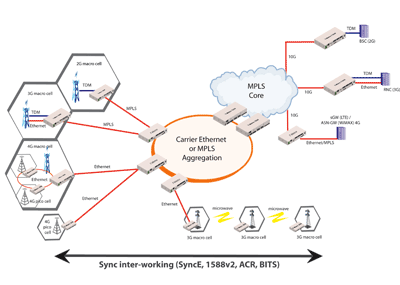Migration from 2G/3G to 4G LTE
BY GREG GUM
SVP, Chief Marketing and Business Development Officer
Telco Systems
www.telco.com
Mobile operators are facing huge challenges as the demand for broadband mobile services rise in an exponential rate. Many are migrating their networks from 2G/3G to 4G LTE technologies to support the bandwidth demand and service offerings that can improve their revenues and support the explosive growth of smartphones, tablets and other smart Internet-enabled devices.
While 2G/3G technology was designed to deliver voice services with small amounts of data (mainly SMS texts, emails) 4G LTE technologies can integrate data, video and voice services over an IP-based packet-based infrastructure. Since 2G and 3G technologies may coexist with 4G LTE in the network, it is critical that a migration process be put in place to accommodate legacy cellular technologies while assuring a smooth migration path.
Migration strategies
Solutions have been developed for mobile backhaul to help operators accommodate these challenges as they move to a pure packet-based 4G LTE network.
Cost-effective small and medium cell site demarcation that supports carrier Ethernet transport, together with E1/T1 TDM ports for circuit emulation traffic accommodate higher rates of data transmission over Ethernet while maintaining TDM-based connections used for voice. These devices enable ACR, syncE, and IEEE 1588v2, and can serve as a 1588v2 client, master, or boundary clock.
These new demarcation devices also support mobile carrier “hotels,” where several operators and radio technologies may coexist at the tower site. By supporting both legacy E1/T1 ports and packet-based Ethernet connections, they can aggregate multiple radios and microwave links from several operators. To accommodate higher port capacity and multiple 1 G and increasingly 10 G Ethernet connections, many devices have modules that can support legacy E1/T1 ports and/or additional Ethernet interfaces to accommodate different use cases for cell site towers that require different technology interfaces (e.g., 2G, 3G, WiMAX, and 4G radios).
Migration to 4G LTE and LTE-Advanced networks
The primary drive towards LTE comes from the operator’s need for more network capacity, performance management, and improved efficiencies to drive down the unit cost of delivering traffic.
While there have been debates about what constitutes true 4G LTE capabilities, the 3rd Generation Partnership Project (3GPP) standardized the LTE system to deliver capacity, data throughput enhancements, and low latency, for support of new services and features requiring higher levels of capability and performance.
In October 2010 the ITU accepted and officially designated LTE-Advanced (IMT-Advanced) for 4G technology which is now the accepted specifications marketed as true next-generation 4G mobile phone and Internet access services or simply branded as “LTE-A” (see www.gsacom.com). Several carriers (e.g. NTT, SKT, ATT Mobile) are already deploying or committed to deploy LTE-A capable of achieving transmission data rates of approximately 1 Gbit/s on the downlink and 200 Mbits/s on the uplink.
Some of the key features of IMT-Advanced LTE-A specification are;
• Worldwide functionality and roaming
• Compatibility of services
• Interworking with other radio access systems
• Enhanced peak data rates to support advanced services and applications (100 Mbit/s for high and 1 Gbit/s for low mobility)

Architectural implications of LTE
With these new standards set for LTE, we have seen 49 commercial networks deployed in 2011 that provided important data points on how we shape the next-generation mobile network. Several factors have forced changes in how operators architect their mobile networks from today’s typical architectural designs to accommodate LTE.
1. The mix of traffic has changed significantly with mobile data subscriber usage doubling every year and expected to do so through 2014.
2. Mobile user saturation has increasingly grown as the primary method of choice for voice access.
3. Diminishing returns in spectral efficiency because of theoretical limits to the efficiency of a radio access network (RAN), continued growth of bandwidth becomes dependent on increased spectrum availability, re-farming, and alternative cloud RAN (C-RAN) and antenna deployments rather than just technology improvements to existing RAN gear (see: “Mobile backhaul in Cloud RAN architecture” www.telco.com/files/c-ran-application-note.pdf).
These three factors have forced operators to modify and flatten their network architectures to accommodate fewer network elements by use of fewer base station controllers, simplifying the data and control plane, and relying on higher-speed packet-based fiber or microwave backhaul links.
Other cost-savings strategies being considered by the mobile operators include the use of smaller distributed devices such as femto- and picocell deployments as the distributed nodes for data offload and distributed small site cells that offer lower-cost alternatives to augment coverage without requiring full base station deployments.
The net effect of these changes is a smaller access layer confined to the cell site, a distribution layer composed of a high-speed mobile backhaul network, mobile gateways and network services nodes, and a core layer that grows in tandem with the distribution of the gateways and services to minimize CAPEX spend as they move to support the new LTE advanced specifications. ■
Advertisement
Learn more about Telco Systems





